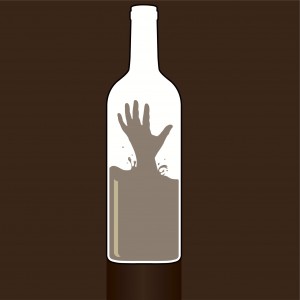
The literature on the efficacy of psychological treatments for excessive drinking is vast, but investigations into effectiveness of these treatments in individuals with other clinical diagnoses are considerably more limited. A recent paper published in Acta Psychiatrica Scandinavica reviewed the effectiveness of manual guided treatments for excessive alcohol consumption in individuals with a psychotic disorder.
This is a particularly important issue; NICE estimates that 40% of individuals with psychotic disorders have some form of substance use disorder, with alcohol misuse making up a significant portion of this. This, in combination with other negative lifestyles that are prevalent in this group (e.g. smoking, sedentary behavior and high fat diets), results in an increased risk of cardiovascular disease, the most common cause of death in patients with psychotic disorders. Furthermore, core healthcare costs in patients with co-existing substance misuse were double that than those with only psychosis (McCrone et al., 2000).
The review article in question looks at the efficacy of interventions for heavy alcohol use in both inpatients and outpatients with psychotic disorders. As well as conducting a purely narrative review the authors also compare the effect sizes for changes in alcohol consumption following motivational interviewing (MI) and cognitive behavior therapy (CBT) with control interventions. It revealed that active and control interventions both reduced excessive alcohol use.
Methods

This review focused on treatment outcomes for excessive alcohol consumption in people with psychotic disorders
To conduct this literature review the authors searched the research literature for articles that investigated treatment outcomes for excessive alcohol consumption in people with psychotic disorders. The review is concerned with the alcohol-related outcomes and does not analyse the impact of treatment on the psychotic disorder. Inclusion criteria for the review were:
- Reported non-pharmacological randomised controlled trials of treatments
- Addressed alcohol use in patients with a psychotic disorder
- Used a treatment manual for treating alcohol consumption
- Had alcohol consumption measures in the outcomes
This search produced seven papers for the narrative review. The authors compared CBT and MI aimed at reducing drinking (active intervention conditions) with treatment as usual, psychoeducation, or standard assessment (control intervention conditions). In addition, the authors also calculated effect sizes for the alcohol-related outcomes within the studies, although notably this was not utilised to compare effect sizes across the studies (due to sampling, treatment and alcohol use assessment diversity). This heterogeneity in the literature resulted in the authors producing a thorough systematic review, although inevitably this limits the number of papers reviewed.
Results
This is what they found:
- Six out of the seven studies found decreased alcohol consumption following baseline assessment.
- CBT and MI (active treatment interventions), psychoeducation and brief assessment interview (control interventions) all resulted in a decline in alcohol use, with little difference in effect sizes between interventions.
- In the one study in which patients had clinically defined comorbid substance abuse, MI and a self help booklet (control) both reduced alcohol consumption at 3 month, 6 month, 1 year and 4 year follow up.
- There was some evidence that CBT and MI for excessive alcohol use improved other clinical outcomes e.g. anxiety and depression compared to control groups.

Overall, active interventions were not significantly better than control intervention conditions at reducing alcohol use
Conclusions
- Overall, active interventions were not significantly better than control intervention conditions at reducing alcohol use. Both decreased alcohol consumption.
- This finding was not affected by whether patients had clinically diagnosed substance use disorder or subclinical hazardous drinking patterns.
- Active interventions may improve other outcomes beyond excessive alcohol use although the evidence for this is tentative.
The authors concluded
The clinically important reductions in alcohol use in the control conditions highlight that even minimal assessment procedures and psychoeducation instil ongoing behaviour change in patients with psychosis.
To summarise, this review indicates that any form of patient contact improves alcohol outcomes in this sample. This contact can be in the form of active interventions that target reductions in drinking (CBT, MI) or merely assessment interviews or non alcohol-specific psychoeducation, all these forms of patient contact will equally improve alcohol outcomes. Overall this review offers some clarity to the literature regarding the impact of treatments for excessive alcohol consumption in patients with psychosis; the calculations of effect sizes are particularly useful and offer clarity to the literature. The authors acknowledge that the number of scientifically rigorous studies investigating this particular issue is limited, and make recommendations for future research. The lack of standardized assessment of alcohol use within the studies seems to be a major issue that prevents the necessary meta-analysis in this area. The current review certainly highlights the paucity of well controlled research in this area; indeed, until well controlled RCTs are conducted then any conclusions regarding the effectiveness of treatments are tentative.
For a more in depth analysis the elf encourages readers to look the 2011 NICE guidelines on assessment and management of psychosis with coexisting substance misuse. This covers a broad range of interventions although it still suffers from a lack of consistency in the measurement of alcohol related outcomes.
Links
Baker AL, Hiles SA, Thornton LK, Hides L, Lubman DI. A systematic review of psychological interventions for excessive alcohol consumption among people with psychotic disorders. Acta Psychiatrica Scandinavica 2012; 126 (4): 243-255. DOI: 10.1111/j.1600-0447.2012.01885.x.

@Mental_Elf Thank you for this.
Treatment of excessive alcohol use in people with psychotic disorders: Non-intervention specific improvements – http://t.co/azJ2MhuXUE
http://t.co/TXick5amKD great blog post on #interventions for #alcohol in people with #psychosis by @ChristiansenLiv for @Mental_Elf
My blog for the mental elf: Treatment of excessive alcohol use in people with psychotic disorders http://t.co/bXDZVwu1Lw via @sharethis
New @Mental_Elf post from @ChristiansenLiv: Treatment of excessive alcohol use in people with psychotic disorders http://t.co/mAurRnaiwX
Excessive alcohol in psychosis: even control interventions produce improvements. http://t.co/MDdUQyyidx #neuro #psych
http://t.co/gEQQU3vtQw
Treatment of excessive alcohol use in people with psychotic disorders: Non-intervention specific improvements http://t.co/NVsOgn5uSO